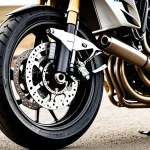Tools and Materials Required for Spark Plug Replacement
For a Yamaha XSR700 spark plug replacement, having the right tools is crucial. Begin with a quality socket wrench paired with a spark plug socket, essential for efficiently removing and installing spark plugs. These tools ensure a secure fit without damaging the spark plugs or engine components. Additionally, always choose a spark plug socket that includes an extension bar; this facilitates reaching deep-seated plugs within the engine compartment.
Selecting the appropriate spark plug for the Yamaha XSR700 enhances performance. It’s advisable to consult the user manual or a reputable dealer for recommended spark plug types, specifically designed for this model. Iridium or platinum variants often provide longer life and better efficiency compared to standard plugs.
Avez-vous vu cela : Master Your Triumph Tiger 900: The Effortless Guide to Replacing Rear Brake Pads Like a Pro
Quality materials are pivotal. They not only prevent unexpected road mishaps but also ensure that your motorcycle runs smoothly. It’s tempting to opt for cheaper alternatives; however, investing in high-grade materials such as anti-seize compound and dielectric grease ensures optimal spark plug performance and longevity. These reduce corrosion risks and facilitate easier future removals.
Remember, using trusted tools and materials can significantly improve your motorcycle’s operation, providing a safer and more enjoyable ride.
Cela peut vous intéresser : Mastering Your Suzuki Intruder M1800R: The Definitive Handbook for Oil Pump Inspection and Optimization for Maximum Performance
Safety Precautions Before Starting
Taking necessary safety precautions is vital for a smooth and secure spark plug replacement. Begin by disconnecting the battery to prevent potential electrical issues during the process. This simple step can avert accidental sparks and electrical shocks, ensuring your safety.
Always don proper clothing and safety gear. Use gloves and wear impact-resistant goggles to protect your hands and eyes from debris and unexpected splashes. Long sleeves or a jacket also safeguard against burns or scratches.
Working in a well-ventilated area is crucial. Motorcycle maintenance, like spark plug replacement, often involves exposure to fumes that can be harmful. Conducting the procedure outdoors or in a space with good airflow mitigates the risks associated with inhaling these fumes.
Additionally, ensure the work surface is stable and free from clutter. A clean and organised workspace promotes efficiency and reduces accidents. Lastly, keep a fire extinguisher nearby for emergencies. Mistakes can happen, and having an extinguisher within arm’s reach offers peace of mind.
By considering these safety tips, you can confidently and safely carry out a successful spark plug replacement on your Yamaha XSR700.
Step-by-Step Procedure for Replacing Spark Plugs
Replacing the spark plugs in your Yamaha XSR700 involves a series of systematic steps. This guide ensures a smooth process.
Preparing the Motorcycle
To begin, ensure that the motorcycle is turned off and the engine is cool to prevent burns. Disconnect the battery to eliminate any risk of electric shock. Place the motorcycle on a stable surface with ample light, enabling clear visibility of the engine components.
Removing the Old Spark Plugs
First, locate the spark plug wires. Gently twist and pull them from the spark plugs to avoid damage. Use a spark plug socket attached to a socket wrench to loosen and remove each spark plug carefully. Handle them with care to avert stripping the threads.
Installing the New Spark Plugs
Inspect the new plugs for any damage before installation. Apply a small amount of anti-seize compound to the threads, enhancing future removal. Thread each spark plug by hand to avoid cross-threading, then tighten with a socket wrench. Reattach the spark plug wires securely.
Common errors include overtightening or cross-threading, so attention to detail is paramount. Adequate preparation and meticulous handling can lead to a successful spark plug replacement, ensuring your Yamaha XSR700 runs at optimum performance.
Troubleshooting Common Issues
Facing issues with your Yamaha XSR700’s spark plugs can be frustrating but often manageable with some strategic troubleshooting. First, signs of spark plug problems include reduced engine performance, difficulty starting, or noticeable misfiring. These indicators usually suggest that the spark plugs may be worn out and require maintenance.
If you experience misfiring or the engine is having trouble starting, begin by checking the spark plug connections to ensure they are securely attached. Verify the plug’s condition—if it’s oily or covered in soot, cleaning might solve the problem. However, if cleaning appears ineffective, replacement may be necessary.
Sometimes, even after addressing these issues, the motorcycle might continue to exhibit problems. This scenario is when it’s advisable to consult a professional mechanic, especially if you’re unfamiliar with complex engine diagnostics. They can provide an in-depth analysis and rectify the problem effectively.
Consistent with this approach, monitoring your motorcycle and addressing problems promptly can prevent costlier repairs and ensure optimal performance. Always bear in mind the importance of using recommended spark plug types for your Yamaha XSR700, as they’re designed for best performance and longevity.
Estimated Costs of Spark Plug Replacement
Replacing spark plugs in your Yamaha XSR700 can vary in cost depending on whether you opt for a DIY approach or professional services. Understanding these expenses is essential for effective budgeting.
Breakdown of Costs
- Tools: A quality socket wrench with spark plug socket might cost around $20-$40. Investing in an extension bar can add $10.
- Spark Plugs: Prices for iridium or platinum plugs, which are often recommended, typically range from $10-$25 per plug, driven by their enhanced durability and performance.
- Materials: Essentials such as anti-seize compound and dielectric grease may add $5-$15 to your expense.
DIY vs. Professional Services
Going the DIY route can be cost-effective, typically under $100 for the entire spark plug replacement, including tools and materials. However, engaging professional services may incur additional labor costs, ranging from $50-$100, depending on the mechanic’s rate.
Budgeting Tips
Consider setting aside an annual maintenance fund for the Yamaha XSR700 to cover unexpected costs. Regular saving can alleviate financial stress and ensure your motorcycle is always in peak condition. Prioritize quality when purchasing tools and plugs to maximize performance and longevity, justifying initial expenses with future savings.









